- Home
- Kathy Reichs
Break No Bones
Break No Bones Read online
“FANS OF TV’S CSI: CRIME SCENE INVESTIGATION SHOULD BE IN HEAVEN” (People) following Kathy Reichs’s acclaimed forensic anthropologist inside a case as explosive as today’s headlines.
To some, the dead are a commodity. For Tempe Brennan, they hold the key to cracking a horrific crime ring.
Among the ancient remains in a Native American burial ground, Tempe discovers a fresh skeleton—and what began as an ordinary teaching stint at an archeology field school in Charleston, South Carolina, fast becomes a heated investigation into an alarming pattern of homicides. The clues hidden in the bones lead to a street clinic where a monstrous discovery awaits, and Tempe—whose personal life is in upheaval, with two men competing for her—can’t afford any distractions as she pieces together a shattering and terrifying puzzle.
“A RARE TREAT. . . . MESMERIZING.”
—Ann Rule
“ENGROSSING.”
—Entertainment Weekly
“TEMPE BRENNAN IS THE LAB LADY MOST LIKELY TO DETHRONE PATRICIA CORNWELL’S KAY SCARPETTA.”
—USA Today
Includes a bonus epilogue:
“FROM THE FORENSIC FILES OF DR. KATHY REICHS”
Also inside: read an excerpt from Bones to Ashes—now a Scribner hardcover
Register online at www.SimonandSchuster.com for more information on this and other great books.
ABOUT THE AUTHOR
KATHY REICHS, like her fictional creation Temperance Brennan, is a board-certified forensic anthropologist for the Laboratoire de Sciences Judiciaires et de Médecine Légale for the province of Quebec, a position she also held at the Office of the Chief Medical Examiner, State of North Carolina. She is Vice President of the American Academy of Forensic Sciences and serves on the National Police Services Advisory Council in Canada. A professor of anthropology at the University of North Carolina at Charlotte, Dr. Reichs received her Ph.D. at Northwestern University. She now divides her time between Charlotte and Montreal. Her debut novel, Déjà Dead, brought her fame when it became a New York Times bestseller, a #1 international bestseller, and winner of the 1997 Ellis Award for Best First Novel. Bones to Ashes, her tenth Temperance Brennan novel, is currently available in hardcover from Scribner.
Her website is www.kathyreichs.com.
“Temperance Brennan is the real thing.”
—Newsday (New York)
“The science is fascinating. . . .”
—The New York Times
“The queen of forensic thrillers.”
—Western Cape City Vision
“You’ll be up most of the night” (Entertainment Weekly) with Kathy Reichs’s suspense-charged international bestsellers featuring forensic anthropologist Dr. Temperance Brennan
BREAK NO BONES
“Reichs’s down-to-earth heroine is an appealing creation, who deftly juggles personal problems with professional challenges. . . . This novel confirms the series’ place in the front rank of . . . forensic thrillers.”
—Publishers Weekly
“Reichs’s seamless blending of fascinating science and dead-on psychological portrayals, not to mention a whirlwind plot, make Break No Bones a must-read.”
—Jeffery Deaver, New York Times bestselling author of The Sleeping Doll
“A great read. . . . Reichs writes rings around Patricia Cornwell.”
—Buffalo News (NY)
Also available from Simon & Schuster Audio
“Kathy Reichs is a working forensic anthropologist who can also write! I am awed by her ability to demonstrate what I call ‘the silent secrets in the bones.’. . . Break No Bones is her best yet.”
—Ann Rule, New York Times bestselling author of Too Late to Say Goodbye
CROSS BONES
“A spirited rival to The Da Vinci Code. . . . Reichs is in top form.”
—Sunday Times (London)
“A riveting thriller. . . . Reichs takes Dan Brown’s religious conspiracy theory one step further.”
—Charlotte Observer (NC)
MONDAY MOURNING
“Breathtaking technical detail.”
—Entertainment Weekly
“The science is downright snazzy, the mystery plenty devious. . . .”
—Houston Chronicle
BARE BONES
“Right up there with Patricia Cornwell’s early Kay Scarpetta mysteries. . . . [Tempe’s] dedication, intelligence, dry wit, and femininity really shine through.”
—Booklist
GRAVE SECRETS
“Riveting.”
—St. Louis Post Dispatch
FATAL VOYAGE
“The plot moves with electric force. . . . Morbid yet captivating.”
—Publishers Weekly
Praise for her #1 international bestsellers
DEADLY DÉCISIONS
“A high-octane forensic thriller.”
—People
“Reichs has brought the detective story into the twenty-first century.”
—The Toronto Sun
DEATH DU JOUR
“Another scary ride through evil past and present. Read it and creep.”
—Mademoiselle
DÉJÀ DEAD
Winner of the Crime Writers of Canada’s Arthur
Ellis Award for Best First Novel
“Déjà Dead can lie side-by-side with the works of Patricia Cornwell. . . . Both do a fine job of telling a good, sometimes scary tale.”
—The Washington Times
“Scary enough to keep the lights on and the dog inside. Reichs is that good.”
—Daily News (New York)
ALSO BY KATHY REICHS
BONES TO ASHES
BREAK NO BONES
CROSS BONES
MONDAY MOURNING
BARE BONES
GRAVE SECRETS
FATAL VOYAGE
DEADLY DÉCISIONS
DEATH DU JOUR
DÉJÀ DEAD
Thank you for purchasing this Pocket Books eBook.
Sign up for our newsletter and receive special offers, access to bonus content, and info on the latest new releases and other great eBooks from Pocket Books and Simon & Schuster.
or visit us online to sign up at
eBookNews.SimonandSchuster.com
POCKET BOOKS, a division of Simon & Schuster, Inc.
1230 Avenue of the Americas, New York, NY 10020
www.SimonandSchuster.com
This book is a work of fiction. Names, characters, places and incidents are products of the author’s imagination or are used fictitiously. Any resemblance to actual events or locales or persons living or dead is entirely coincidental.
Copyright © 2006 by Temperance Brennan, L.P.
Originally published in hardcover in 2006 by Scribner
All rights reserved, including the right to reproduce this book or portions thereof in any form whatsoever.
For information address Scribner, 1230 Avenue of the Americas, New York, NY 10020
ISBN-13: 978-0-7434-5303-5
ISBN-10: 0-7434-5303-4
ISBN-13: 978-1-4165-3521-8 (eBook)
This Pocket Books premium paperback edition September 2007
POCKET and colophon are registered trademarks of Simon & Schuster, Inc.
Cover illustration by Shasti O'Leary Soundant
A version of “From the Forensic Files of Kathy Reichs” previously appeared in the November 28, 2005, issue of TV Guide.
In loving memory of
Arvils Reichs
February 9, 1949–February 23, 2006
Dusi Saldi
Contents
Acknowledgments
Chapter 1
Chapter 2
Chapter 3
Chapter 4
Chapter 5
Chapter 6
Chapter 7
Chapter 8
Chapter 9
Chapter 10
Chapter 11
Chapter 12
Chapter 13
Chapter 14
Chapter 15
Chapter 16
Chapter 17
Chapter 18
Chapter 19
Chapter 20
Chapter 21
Chapter 22
Chapter 23
Chapter 24
Chapter 25
Chapter 26
Chapter 27
Chapter 28
Chapter 29
Chapter 30
Chapter 31
Chapter 32
Chapter 33
Chapter 34
Chapter 35
Chapter 36
Chapter 37
Chapter 38
Chapter 39
Chapter 40
Epilogue
From the Forensic Files of Dr. Kathy Reichs
‘Bones To Ashes’ Teaser
Acknowledgments
For their willingness to help, and for the knowledge and support they provided, I owe thanks to many.
Ted Rathbun, Ph.D., University of South Carolina, Columbia (retired), provided information on South Carolina archaeology. Robert Dillon, Ph.D., College of Charleston, gave guidance on malacology. Lee Goff, Ph.D., Chaminade University, is, and will always be, the guru of bugs.
Detective Chris Dozier, Charlotte-Mecklenburg Police Department, coached me on the use of AFIS. Detective John Appel, Guilford County, North Carolina, Sheriff’s Department (retired), and Detective Investigator Joseph T. Noya, Jr., NYPD Crime Scene Unit, helped with police minutiae.
Linda Kramer, R.N., Michelle Skipper, M.B.A., and Eric Skipper, M.D., helped with the non-Hodgkins lymphoma scenario.
Kerry Reichs kept me accurate on Charleston geography. Paul Reichs provided information on legal proceedings and offered useful comments on early versions of the manuscript.
Others helped but prefer to remain anonymous. You know who you are. Thanks a million.
J. Lawrence Angel was one of the grand old men of forensic anthropology. His chapter on the Spanish windlass and vertebral fracture really does exist: Angel, J. L., and P. C. Caldwell, “Death by strangulation: a forensic anthropological case from Wilmington, Delaware,” in Human Identification: Case Studies in Forensic Anthropology, eds. T. A. Rathbun and J. E. Buikstra (Springfield, Ill.: Charles C. Thomas, 1986).
Heartfelt thanks to my editor, Nan Graham. Break No Bones benefited greatly from your advice. Thanks also to Nan’s assistant, Anna deVries. And thanks to Susan Sandon, my editor across the pond.
Last, but far from least, thanks to my agent, Jennifer Rudolph-Walsh, who always has time for a word of encouragement. And who always makes me feel smart. And pretty.
Though Break No Bones is a work of fiction, I have tried to keep details of the story honest. If there are mistakes, I own them. Don’t blame the folks acknowledged above.
1
NEVER FAILS. YOU’RE WRAPPING UP THE operation when someone blunders onto the season’s big score.
OK. I’m exaggerating. But it’s damn close to what happened. And the final outcome was far more disturbing than any last-minute discovery of a potsherd or hearth.
It was May 18, the second-to-the-last day of the archaeological field school. I had twenty students digging a site on Dewees, a barrier island north of Charleston, South Carolina.
I also had a journalist. With the IQ of plankton.
“Sixteen bodies?” Plankton pulled a spiral notebook as his brain strobed visions of Dahmer and Bundy. “Vics ID’d?”
“The graves are prehistoric.”
Two eyes rolled up, narrowed under puffy lids. “Old Indians?”
“Native Americans.”
“They got me covering dead Indians?” No political correctness prize for this guy.
“They?” Icy.
“The Moultrie News. The East Cooper community paper.”
Charleston, as Rhett told Scarlett, is a city marked by the genial grace of days gone by. Its heart is the Peninsula, a district of antebellum homes, cobbled streets, and outdoor markets bounded by the Ashley and Cooper rivers. Charlestonians define their turf by these waterways. Neighborhoods are referred to as “West Ashley” or “East Cooper,” the latter including Mount Pleasant, and three islands, Sullivan’s, the Isle of Palms, and Dewees. I assumed plankton’s paper covered that beat.
“And you are?” I asked.
“Homer Winborne.”
With his five-o’clock shadow and fast food paunch, the guy looked more like Homer Simpson.
“We’re busy here, Mr. Winborne.”
Winborne ignored that. “Isn’t it illegal?”
“We have a permit. The island’s being developed, and this little patch is slated for home sites.”
“Why bother?” Sweat soaked Winborne’s hairline. When he reached for a hanky, I noticed a tick cruising his collar.
“I’m an anthropologist on faculty at the University of North Carolina at Charlotte. My students and I are here at the request of the state.”
Though the first bit was true, the back end was a stretch. Actually, it happened like this.
UNCC’s New World archaeologist normally conducted a student excavation during the short presummer term each May. In late March of this year, the lady had announced her acceptance of a position at Purdue. Busy sending out résumés throughout the winter, she’d ignored the field school. Sayonara. No instructor. No site.
Though my specialty is forensics, and I now work with the dead sent to coroners and medical examiners, my graduate training and early professional career were devoted to the not so recently deceased. For my doctoral research I’d examined thousands of prehistoric skeletons recovered from North American burial mounds.
The field school is one of the Anthropology Department’s most popular courses, and, as usual, was enrolled to capacity. My colleague’s unexpected departure sent the chair into a panic. He begged that I take over. The students were counting on it! A return to my roots! Two weeks at the beach! Extra pay! I thought he was going to throw in a Buick.
I’d suggested Dan Jaffer, a bioarchaeologist and my professional counterpart with the medical examiner/coroner system in the great Palmetto State to our south. I pleaded possible cases at the ME office in Charlotte, or at the Laboratoire de sciences judiciaires et de médecine légale in Montreal, the two agencies for which I regularly consult.
The chair gave it a shot. Good idea, bad timing. Dan Jaffer was on his way to Iraq.
I’d contacted Jaffer and he’d suggested Dewees as an excavation possibility. A burial ground was slated for destruction, and he’d been trying to forestall the bulldozers until the site’s significance could be ascertained. Predictably, the developer was ignoring his requests.
I’d contacted the Office of the State Archaeologist in Columbia, and on Dan’s recommendation they’d accepted my offer to dig some test trenches, thereby greatly displeasing the developer.
And here I was. With twenty undergraduates. And, on our thirteenth and penultimate day, plankton-brain.
My patience was fraying like an overused rope.
“Name?” Winborne might have been asking about grass seed.
I fought back the urge to walk away. Give him what he wants, I told myself. He’ll leave. Or, with luck, die from the heat.
“Temperance Brennan.”
“Temperance?” Amused.
“Yes, Homer.”
Winborne shrugged. “Don’t hear that name so much.”
“I’m called Tempe.”
“Like the town in Utah.”
“Arizona.”
“Right. What kind of Indians?”
“Probably Sewee.”
“How’d you know stuff was here?”
“Through a colleague at USC-Columbia.”
“How’d he know?”
“He spotted small mounds while doing
a survey after the news of an impending development was announced.”
Winborne took a moment to make notes in his spiral. Or maybe he was buying time to come up with his idea of an insightful question. In the distance I could hear student chatter and the clatter of buckets. Overhead, a gull cawed and another answered.
“Mounds?” No one was going to short-list this guy for a Pulitzer.
“Following closure of the graves, shells and sand were heaped on top.”
“What’s the point in digging them up?”
That was it. I hit the little cretin with the interview terminator. Jargon.
“Burial customs aren’t well known for aboriginal Southeastern coastal populations, and this site could substantiate or refute ethnohistoric accounts. Many anthropologists believe the Sewee were part of the Cusabo group. According to some sources, Cusabo funerary practices involved defleshing of the corpse, then placement of the bones in bundles or boxes. Others describe the scaffolding of bodies to allow decomposition prior to burial in common graves.”
“Holy crap. That’s gross.”
“More so than draining the blood from a corpse and replacing it with chemical preservatives, injecting waxes and perfumes and applying makeup to simulate life, then interring in airtight coffins and vaults to forestall decay?”
Winborne looked at me as though I’d spoken Sanskrit. “Who does that?”
“We do.”
“So what are you finding?”
“Bones.”
“Just bones?” The tick was now crawling up Winborne’s neck. Give a heads-up? Screw it. The guy was irritating as hell.
I launched into my standard cop and coroner spiel. “The skeleton paints a story of an individual. Sex. Age. Height. Ancestry. In certain cases, medical history or manner of death.” Pointedly glancing at my watch, I followed with my archaeological shtick. “Ancient bones are a source of information on extinct populations. How people lived, how they died, what they ate, what diseases they suffered—”
Winborne’s gaze drifted over my shoulder. I turned.
Topher Burgess was approaching, various forms of organic and inorganic debris pasted to his sunburned torso. Short and plump, with knit cap, wire rims, and muttonchop sideburns, the kid reminded me of an undergraduate Smee.

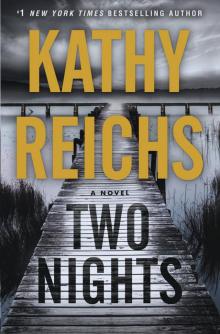 Two Nights
Two Nights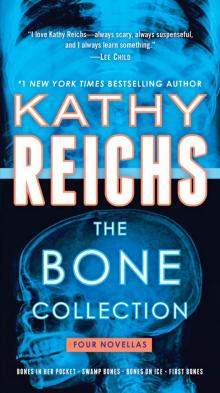 The Bone Collection: Four Novellas
The Bone Collection: Four Novellas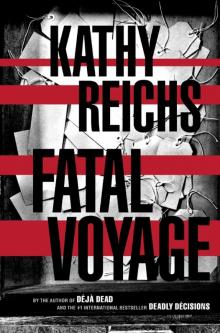 Fatal Voyage
Fatal Voyage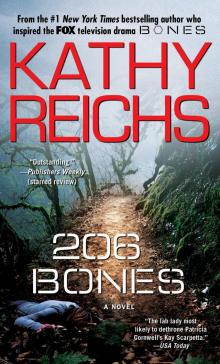 206 Bones
206 Bones Bones to Ashes
Bones to Ashes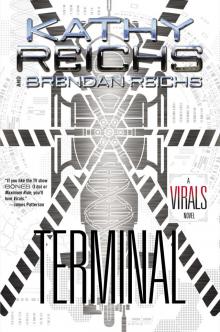 Terminal
Terminal Monday Mourning
Monday Mourning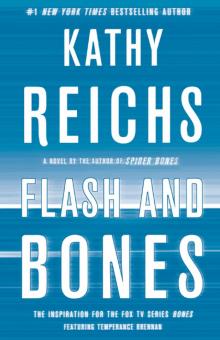 Flash and Bones
Flash and Bones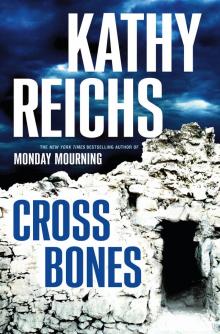 Cross Bones
Cross Bones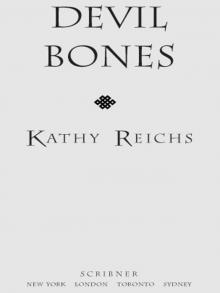 Devil Bones
Devil Bones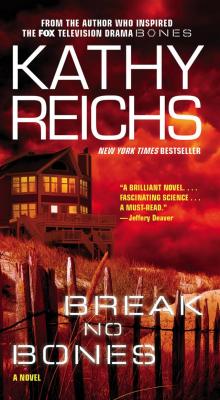 Break No Bones
Break No Bones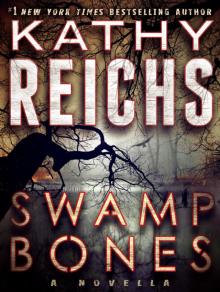 Swamp Bones
Swamp Bones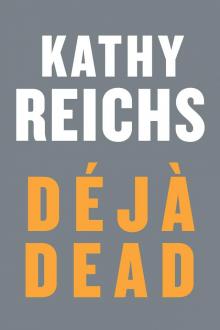 Déjà Dead
Déjà Dead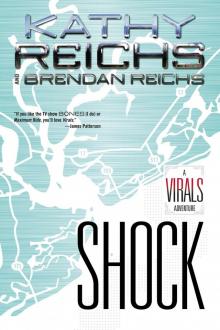 Shock
Shock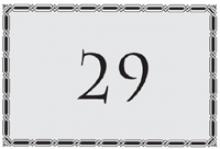 Spider Bones
Spider Bones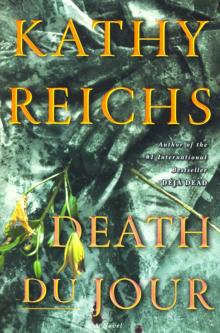 Death Du Jour
Death Du Jour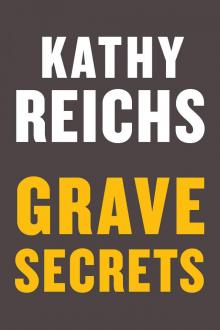 Grave Secrets
Grave Secrets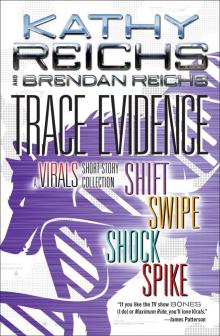 Trace Evidence: A Virals Short Story Collection
Trace Evidence: A Virals Short Story Collection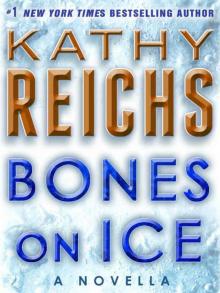 Bones on Ice
Bones on Ice The Bone Code
The Bone Code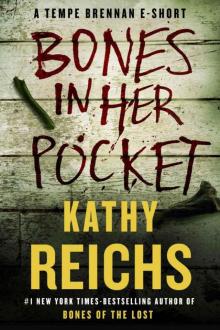 Bones in Her Pocket
Bones in Her Pocket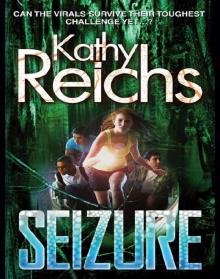 Seizure:
Seizure: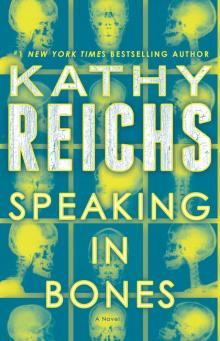 Speaking in Bones
Speaking in Bones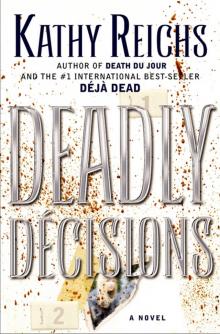 Deadly Decisions
Deadly Decisions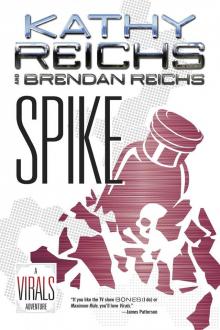 Spike
Spike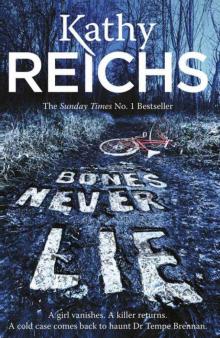 Bones Never Lie
Bones Never Lie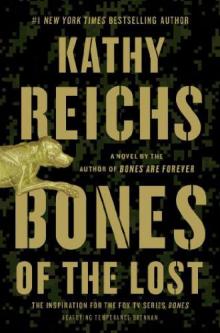 Bones of the Lost
Bones of the Lost Virals 03.5 - Swipe
Virals 03.5 - Swipe Exposure
Exposure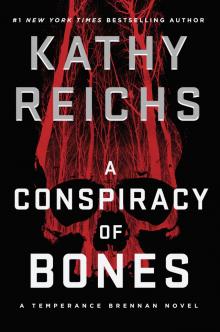 A Conspiracy of Bones
A Conspiracy of Bones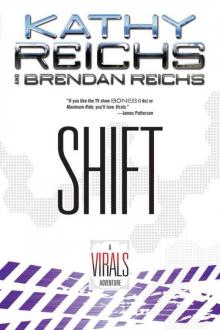 Shift (tory brennan)
Shift (tory brennan)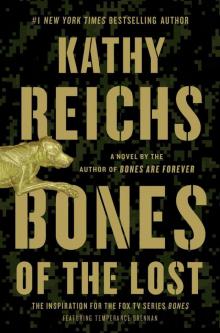 Bones of the Lost: A Temperance Brennan Novel tb-16
Bones of the Lost: A Temperance Brennan Novel tb-16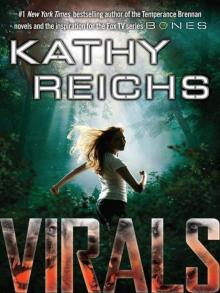 Virals tb-1
Virals tb-1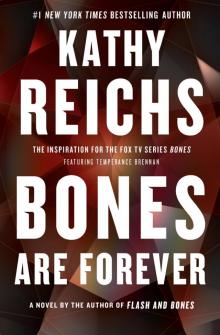 Bones Are Forever tb-15
Bones Are Forever tb-15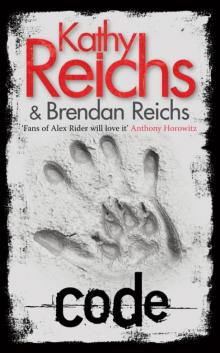 Code tb-3
Code tb-3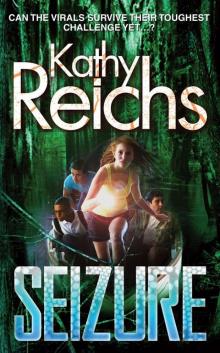 Seizure tb-2
Seizure tb-2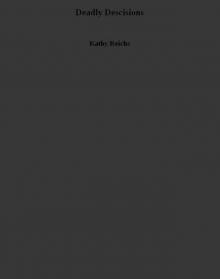 Deadly Descisions
Deadly Descisions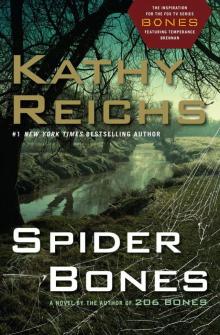 Spider Bones: A Novel
Spider Bones: A Novel